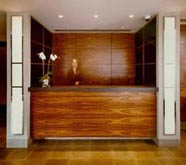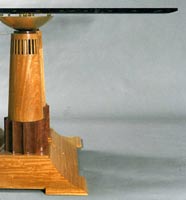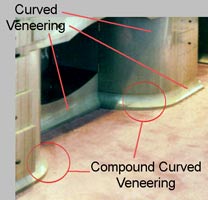|
Veneer
is a very thin sheet of some material that has been
sliced off of a big chunk of that material and used as a facing. Wood
veneer a thin sheet of wood sliced off of a log. Decorative veneers are
shaved off in sheets by shoving a log along a very big knife a peeling
off the slice like an apple peel.
Veneering is the
process of laminating that sheet to a strong backer of another
material. In the case of wood veneering there are two powerful advantages to this type of
manufacturing. The first is to make otherwise very expensive woods
affordable (a log goes alot further when it's sliced really thin), but
more importantly the process of laminating wood (a material that
breaks, splits, expands, and is an otherwise ornery and dimensionally
unstable material) to a stable and strong backer makes the wood stay
put and not crack or distort over time. Much high quality woodwork (pianos, for example) is veneered. Veneering capability is
essential in any interiors fabrication shop.
|
Below are some images of veneer work that we've built.
 |
Flat veneering
Everyone has interacted with flat veneering - plywood is the
most common example, in which layers of veneer are laminated together
to make a thick sandwich. You can veneer anything - you just have to
use the
right glue. For example, very thin shelves that must carry alot of
weight can be made by veneering steel plates with decorative wood
veneers. Veneer doesn't have to be wood - metals can be laminated to
plastics, plastics to wood, wood to glass, glass to metals. But in
order to get away with this type of innovation a deep understanding of
the characteristics of the laminate, the substrate, and the adhesive
that glues them together is essential. All materials change dimensions
back and forth over the course of a year but some with heat, some with
moisture, some with pressure, some with age; all materials have their
own cohesive and adhesive properties each being unique and the adhesive
must be designed with both adherends taken into account. |

|
Curved veneering
Veneering involves pressure (to press the sheet to the shape of the substrate)
and holding time (to hold it there until the glue cures). Veneering
flat sheets just need another flat sheet with some clamps. Curves need
an opposite curve to clamp it in place.
|

|
Compound-Curve veneering
This is not easy - veneer is rigid, like a sheet of paper. It's
difficult to lay a sheet of paper down on a globe or some portion of
one because it has to "stretch". But, with
some veneers it's possible to slice, inlay, slice again, inlay again,
and then soak and press it down on a compound curve and make it look
like it was carved out of solid wood. This photo shows a part of the
piece where flat, curved, and compound-curved veneering all takes
place. This was required because the veneer (English Harewood) is not available in solid wood form.
|
|
|


